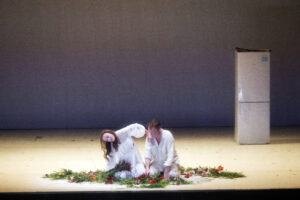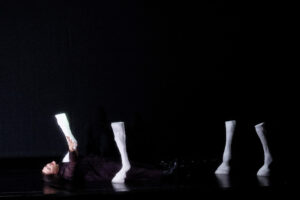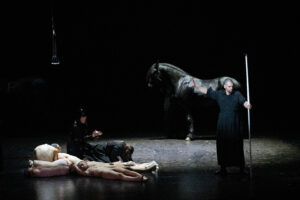Over a decade ago, when Romeo Castellucci’s production of The Four Seasons Restaurant arrived in Poland, Jacek Kopciński bridled at a comment in the Malta Festival programme book: an example of embarrassing vacuousness, “the claptrap, which is so tolerated today and which overgrows theatre programmes, brochures and leaflets, spreads to television and, of course, to the Internet (…), from where it finds its way into reviews and then into master’s theses and doctoral dissertations, subsequently quoted in programmes – and the whole process comes full circle”. Like Kopciński, I am not in the habit of reading previews before a performance, and like him, I often rub my eyes in astonishment, when I read them after seeing the performance in question. However, when confronting the oeuvre of Castellucci, about whom I again agree with Kopciński that he is a director of eschatological premonitions as much well-known as he is misunderstood, I’m afraid of falling into the trap of clichés. The Italian artist’s theatre – unreal, derived from the logic and aesthetics of dreams – features so many symbols and cultural references that a review of each of his productions can become a doctoral dissertation. And be way off the mark, because Castellucci’s stagings are like time bombs. Their various elements keep coming back to the spectator like recovered dreams. They make up false memories, thanks to which the spectator experiences revelation, as it were – for a sequence of several oneiric scenes is able to generate in his or her brain an image which was not there, but which will prove to be the key to interpreting the whole.
I firmly take the view that theatre is not a keyhole and is not to be used to peek at reality: that is why I appreciate Castellucci’s productions so much, and why in describing them I try to resist the temptation to split hairs and pedantically pick out the accumulating signs. I went to see Die Walküre – the second part of Wagner’s tetralogy staged by him – at La Monnaie primarily because of my personal fondness for the work: perfectly constructed in terms of drama and thus enabling the spectator to gain a deep insight into the motivations and feelings of the characters. I was also intrigued by the director’s declaration that he would treat each part of the Brussels Ring not only as an integral part of the cycle, but also as a separate work, governed by its own theatrical logic.
Thus the generally luminous, white and gold Rheingold was followed by a predominantly dark Walküre, speaking, like Castellucci’s other productions, the unique language of his theatre, oriented more towards the image than the word. At times this image was on the verge of visibility, creating an illusion of empty space that the spectators were to fill with their energy and emotions, to sort out the blackness, give meaning to it. Castellucci’s Die Walküre becomes more and more minimalist, conceptual from act to act. In this respect it brings to mind rather obvious associations with Wieland Wagner’s stagings, though it creates a broader framework for the world of myth, placing it – like Pasolini did in his Medea – in the context of the aesthetic experience of various cultures and periods. Hence the references to Christian and Buddhist iconography, hence the allusions to Nietzsche and Dostoyevsky, hence the reference – in my opinion the most significant of all – to Friedrich Hölderlin and his Death of Empedocles.
Nadja Stefanoff (Sieglinde) and Peter Wedd (Siegmund). Photo: Monika Rittershaus
I might have missed the association, if it had not been for the poignant finale, in which Brunhilde disappeared under a blindingly white screen, after which the screen was lifted, revealing a pair of shoes she had left behind. Brunhilde’s rock turns out to be Etna, into whose depths Empedocles threw himself. Castellucci’s entire production is steeped in the thought of Empedocles, the forefather of the philosophy of love, the author of the concept whereby the main forces of order are Love and Strife, and our world comes into being only when the latter, dark force invades the perfect world. Siegmund’s wolf skin, Hunding’s black dog, Fricka’s white doves and Valkyries’ dark horses (it’s been a long time since Castellucci brought such a number of live animals to the stage) are not only the director’s repeated sign of a return to the origins of theatre, but also a reference to Empedocles’ belief in metempsychosis. Empedoclean elements include even the colours of the staging, which, with few exceptions, is dominated by the four elemental colours: black, white, red and various shades of ὠχρός, the colour of the earth.
I admit that Castellucci’s visions are not always consistent with the music, and sometimes make life difficult for the singers (this is especially true of the mesh screen in Acts One and Two, the equivalent of a PVC film curtain, making it difficult for audiences of the artist’s earlier stagings to follow the action). Several images, however, will remain in my memory for a long time: a horse’s eye in a giant circle watching Sieglinde and Siegmund in Act One like an omniscient animal deity; the death of Siegmund, engulfed by a quivering mass of earth, or perhaps lava flowing out from beneath it; the beginning of Act Three, in which nine barely visible horses carry the naked corpses of the fallen warriors onto the stage, and then the Valkyries pile them up, laying them down in rows, throwing one of the corpses into the lap of one of them, who receives him with helpless apathy worthy of Michelangelo’s Vatican sculpture.
Ingela Brimberg (Brunhilde). Photo: Monika Rittershaus
A veritable storm of meanings was carried by the image of the Völsung siblings’ vow of incestuous love. The scene gradually becomes empty. The lovers are left amidst the snowy whiteness, also dressed in white; Siegmund (yes, earlier than in the score) draws a sword from Sieglinde’s womb and opens a wound in her body: a symbol of misfortune, suffering, but in medieval Christian iconography also of the vulva from which a child will be born. This is soon followed by is a veritable orgy of fertility and transgression. The lovers lubricate themselves with blood flowing out of the wound – symbolising the female element of the foetus – and then douse each other with milk, a symbol of the male “white blood”, or sperm, from which the baby’s bones will grow. There is no ash tree on stage. Siegmund puts the Nothung, a decidedly phallic element in this context, into an empty white refrigerator – as if with a subconscious intention of preserving the fruit of the love night. The whole scene can also be interpreted in terms of sacrifice of milk and blood. Or the Old Testament prohibition of combining one substance with another, that is, in the subtext – the prohibition of incest. The abundance of flowers accompanying this initiation also brings to mind some ancient chthonic ritual. It’s been a long time since I saw such a bold yet stunningly beautiful erotic scene in the theatre.
The musical reins of the production were in the hands of Alain Altinoglu – a conductor as far as possible from trying to interpret Wagner in the bombastic Bayreuth style of the 1930s – so it’s not surprising that his choice of cast was different from what many critics expected. The result was generally good, although there were a few disappointments, especially for me, with all my years of watching the Wagnerian “shadow cabinet” in less prominent European theatres. I really liked the fragile, subtle Sieglinde portrayed by the German soprano Nadja Stefanoff, whose voice is relatively small but luminous and natural, with a warm, slightly “old-fashioned” sound and great power of expression. Unfortunately, she did not find her equal in Peter Wedd (Siegmund), an extremely musical singer, whose free-flowing phrasing is reminiscent of the vocal art of his compatriot Walter Widdop. However, Wedd’s handsome, dark tenor shows clear signs of fatigue. Theatre directors clearly missed the moment when Wedd had the makings of one of the more interesting jugendliche Heldentenors of his generation. Now his voice has become dull, lost its harmonics, descended deep into the larynx, which has also resulted in production errors – a great pity, especially given that when I heard his debut in the role in Karlsruhe in 2016, his sonorous, bronze “Wälse! Wälse!” carried over the orchestra with a real squillo. Living proof of the usefulness of taking good care of your vocal instrument was provided on the other hand by Marie-Nicole Lemieux, a singer normally associated with quite a different repertoire, who effortlessly adapted her sonorous, warm and extremely rich-sounding contralto to the by no means easy part of Fricka. I wasn’t entirely convinced by Ingela Brimberg as Brunhilde – hers is a soprano that is powerful, but rather harsh and, in my opinion, with too much vibrato, for which she fortunately managed to make up with great musicality and phenomenal acting. I will be interested in following the career of Gábor Bretz, a Wotan who is still too “youthful”, but is already showing the makings of an excellent lyrical interpreter of the role, as he demonstrated especially in the final farewell scene with Brunhilde. I was a bit disappointed by Ante Jerkunica, whose otherwise beautiful bass is too light for the role of Hunding. A perfectly harmonised (if sometimes a tad too shrill) team of the Valkyries was created by Karen Vermeiren, Tineke van Ingelgem, Polly Leech, Lotte Verstaen, Katie Lowe, Marié-Andrée Bouchard-Lesieur, Iris van Wijnen and Christel Loetzsch.
Gabor Bretz (Wotan). Photo: Monika Rittershaus
The biggest revelation of the evening, however, was Altinoglu, conducting the whole thing with a precision worthy of André Cluytens and attention to narrative cohesion that Charles Munch himself would have been proud of. It was the first time I heard live a truly “French” Wagner, which in this interpretation betrayed non-obvious affinities with Berlioz’s oeuvre, for example. Altinoglu keeps the pulse in check, does not overwhelm with the mass of sound, contrasts the tempos clearly, but always in accordance with the musical logic, and, above all, impresses with his extraordinary attention to detail and ability to bring out surprising sound effects from the texture, especially in the woodwind (phenomenal clarinets and oboes). We could use a few more equally sensitive conductors to finally make a breakthrough in the performance of Wagner’s music, still played with admirable persistence in a quite ahistorical manner.
Some predict that Castellucci’s Brussels stagings will make up the first Ring worthy of our century. They are quite likely right. We live in a civilisation of images, but, fortunately, we are still able to make a distinction between artistry and chutzpah. Castellucci himself once said that good theatre has power. Can create. It testifies to the existence of another, parallel world.
Translated by: Anna Kijak



